10 Clothing Items You Shouldn't Wear on a Walk
These are the items you should leave at home, doctors and fitness experts say.

Though walking is among the simplest and most accessible exercises, fitness experts say it still requires a small amount of preparation. In particular, choosing the right things to wear on your walk can help avoid strain, injury, and discomfort. And with that in mind, knowing which clothing items you should never wear on a walk is just as important.
"Carefully choosing what to wear on walks helps you make sure you're comfortable, safe, and protected from the elements," says Raj Dasgupta, MD, FACP, FCCP, FAASM, medical reviewer for the National Council on Aging (NCOA).
Ready to select your outfit for your next sunset stroll or early morning power walk? Read on to find out which 10 pieces of clothing you should leave behind.
RELATED: Why Walking Just 4,000 Steps a Day Is All Your Brain Needs, Science Says.
1
Items with inside seams
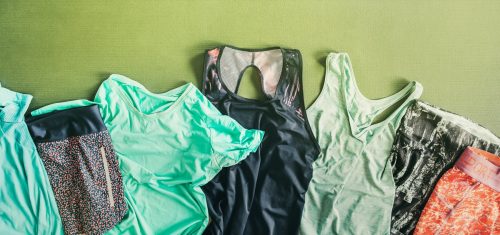
Milica McDowell, MS, DPT, certified exercise physiologist and vice president of operations at Gait Happens, recommends avoiding clothing with inside seams, specifically those that go down your armpit or along the inner thigh.
"These are locations where you could have chafing issues where your skin can get irritated when doing arrhythmic activity like walking," McDowell says. "It's best to wear attire that is more suited for athletics, such as things with flatter seams or seamless outfits if possible."
2
Jackets that prevent airflow

It's easy to throw on a jacket when the air is a bit cooler, but you should consider the outer layer you select. According to Rachel MacPherson, CSCS, CPT, author at Garage Gym Reviews, you should avoid any that may inhibit airflow on your walk.
"Unless you're dealing with a lot of heavy rain or wind, you should avoid wearing coats or jackets that aren't breathable and prevent moisture from moving through them," she cautions. "It's important for your body to dissipate heat through sweat to avoid overheating."
RELATED: Walking for Just 11 Minutes a Day Can Help You Live Longer, New Research Shows.
3
Expensive jewelry

It's an unfortunate reality that we have to be mindful of our personal safety when out for a walk. That's why you might want to consider leaving any expensive jewelry at home before lacing up your sneakers. If you prefer to leave them on, consider concealing them from sight, per McDowell's recommendation.
"When I go on a walk, I tend to wear long sleeves for sun protection, but also to avoid displaying any expensive pieces I may be wearing that day," she shares.
4
Dark colors
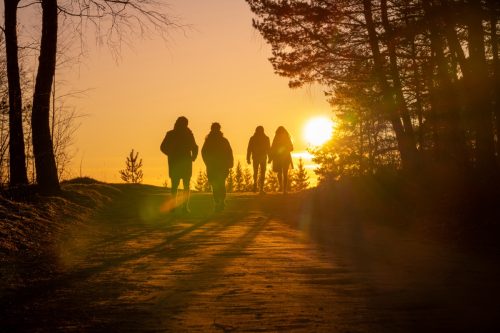
You might not immediately think of it, but color choice is crucial with walking gear as well.
As Dasgupta points out, you should avoid dark colors when going for a walk when it's dark out (like in the early morning before the sun is up or after sunset).
"Wearing dark colors at night can reduce your visibility to passing cars and drivers, increasing the risk of accidents," Dasgupta warns.
5
Unsupportive footwear
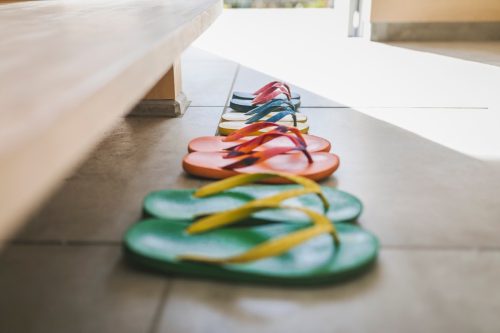
Juju Sheikh, a personal trainer and founder of the fitness app Cloud Nine Collective, says that you should never take a walk in unsupportive footwear. These include flip-flops, sandals, high heels, and sneakers without adequate arch support.
"Walking shoes should provide suitable support around the balls of your feet and your ankles while also being resilient enough to sustain various types of terrain," she tells Best Life.
Caroline Grainger, an ISSA-certified personal trainer at FitnessTrainer, agrees that proper footwear is non-negotiable.
"While most people will be fine wearing sandals or unsupportive sneakers during a walk around the block, if you're going for a longer walk, you want to make sure you're wearing the right shoes," she notes. "Wearing the wrong shoes while walking can lead to blisters, cramps, and even stress fractures."
RELATED: 7 Worst Shoes for Knee Pain, Podiatrists Say.
6
Shoes that aren't specifically for walking
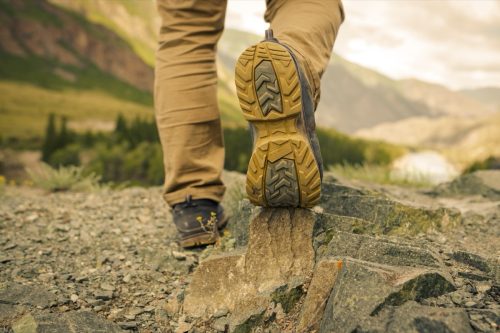
Speaking of unsupportive shoes, experts also recommend leaving all non-walking-specific footwear at home. That includes hiking boots—unless you're setting out on a trail with rough, uneven terrain.
"Avoiding unsupportive shoes is important, but it's also wise to choose shoes that are designed specifically for walking, especially if you will be walking long distances," MacPherson says. "Hiking boots will be too heavy and cumbersome and potentially cause your feet to overheat as well."
Interestingly enough, your running shoes are a no-no as well.
"Running shoes also aren't a great fit because they typically have features that help propel you forward and use a rocking motion which could cause you to become unsteady while you're walking, particularly if you're on uneven surfaces or have poor balance," MacPherson explains. "Instead, choose shoes that are specifically made for walking and offer enough foot and ankle support and cushioning to keep you comfortable and safe."
7
Skirts or dresses without shorts underneath
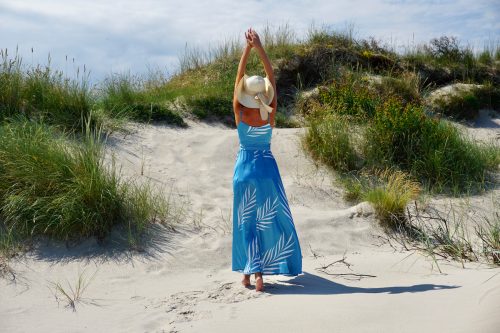
Taking longer walks, especially in high heat, can lead to sweating and chafing. Kevin Le Gall, a fitness expert and the owner and lead editor for Climbing House, says that wearing skirts or dresses without shorts underneath can exacerbate the problem.
"While skirts and dresses can keep you cool, they'll do nothing to prevent chafing in hot temperatures. When you're going for a longer walk, you want to ensure your inner thighs are protected from rubbing against one another," he shares.
8
Heavy, non-breathable fabrics

If you're going for a longer walk or hike, experts recommend opting for breathable, moisture-wicking fabrics.
"Non-breathable fabrics are a bane for a lot of walkers; they are bulky, heavy, and can cause sweating and discomfort," Sheikh says. "They're particularly bad for long walks because they don't let air or moisture pass through very easily, resulting in a lot of heat retention and poor ventilation."
The personal trainer recommends avoiding synthetic blends of fabrics, vinyl, PVC, rubberized fabrics, and heavy denim clothing when out on a walk.
Even everyday clothing items such as jeans and cotton t-shirts can prove heavy and un-absorbent on a walk, says Adrian Todd, an occupational therapist, hiking coach, and founder of Great Minds Think Hike.
RELATED: 26 Amazing Health Benefits of Walking.
9
Unsupportive bras
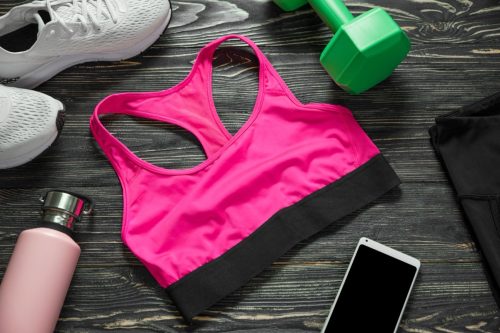
Wearing an unsupportive or uncomfortable bra can also tarnish your walking experience, Sheikh cautions. Underwires, too-tight straps, and unforgiving materials are all common culprits.
"Having an unsupportive bra results in discomfort and strain on your back and shoulders, as well as restricted natural movement. Collectively, this can cause imbalances in your body, potentially resulting in injury if sustained over a long period of time," she explains.
10
Headphones

Headphones are not exactly a clothing item, but several of the experts we spoke to dubbed them a safety risk, especially when you're walking in unfamiliar areas.
"If you're walking in the evening or early morning, trying to beat the heat, you should be careful about wearing headphones," Le Gall advises. "Make sure to stay aware of your surroundings at all times when out on a walk so you can stay safe."





















